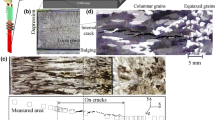Summary
Crack growth rates have been measured in single edge-notched specimens of % MathType!MTEF!2!1!+-% feaafiart1ev1aaatCvAUfeBSjuyZL2yd9gzLbvyNv2CaerbuLwBLn% hiov2DGi1BTfMBaeXafv3ySLgzGmvETj2BSbqefm0B1jxALjhiov2D% aebbfv3ySLgzGueE0jxyaibaiGc9yrFr0xXdbba91rFfpec8Eeeu0x% Xdbba9frFj0-OqFfea0dXdd9vqaq-JfrVkFHe9pgea0dXdar-Jb9hs% 0dXdbPYxe9vr0-vr0-vqpWqaaeaabiGaciaacaqabeaadaqaaqGaaO% qaaiaaikdadaWcbaWcbaGaaGymaaqaaiaaisdaaaaaaa!3E80!\[2\tfrac{1}{4}\]Cr 1 Mo steel loaded in tension at 565 dgC. It is shown that the creep crack growth rate in tests of up to about 2,000 hours duration can be described in terms of the sharp crack stress intensity factor. A correlation is obtained over five orders of magnitude in crack growth rate and the relationship of these results to conventional creep tests is discussed. For the particular test conditions the time required to initiate a crack from a notch is not significant compared with the total times for specimens to fail. Under some conditions high rates of stable crack growth rate can be obtained. The work has obvious potential in the assessment of the integrity of components which contain defects and operate under creep conditions. A possible application of the data to the analysis of a particular thermal fatigue situation is suggested.
Résumé
On a mesuré les vitesses d'accroissement de fissures dans des éprouvettes à entaille simple et latérale d'aciers % MathType!MTEF!2!1!+-% feaafiart1ev1aaatCvAUfeBSjuyZL2yd9gzLbvyNv2CaerbuLwBLn% hiov2DGi1BTfMBaeXafv3ySLgzGmvETj2BSbqefm0B1jxALjhiov2D% aebbfv3ySLgzGueE0jxyaibaiGc9yrFr0xXdbba91rFfpec8Eeeu0x% Xdbba9frFj0-OqFfea0dXdd9vqaq-JfrVkFHe9pgea0dXdar-Jb9hs% 0dXdbPYxe9vr0-vr0-vqpWqaaeaabiGaciaacaqabeaadaqaaqGaaO% qaaiaaikdadaWcbaWcbaGaaGymaaqaaiaaisdaaaaaaa!3E80!\[2\tfrac{1}{4}\]Cr 1 Mo soumis à traction à la température de 565 degrés C. On montre que la vitesse de propagation des fissures de fluage au cours des essais sur des durées allant jusqu'à 2.000 h peut être exprimée par un facteur d'intensité de contraintes à l'extrémité d'une fissure aigüe. La corrélation trouvée s'établit sur cinq ordres de grandeur de la vitesse de propagation. On discute la relation entre ces résultats et ceux obtenus par les essais de fluage conventionnels.
Pour les conditions spécifiques de l'essai, le temps nécessaire à l'amorçage de la fissure à partir d'une entaille n'entre pas en ligne de compte par rapport au temps total nécessaire à la rupture. Sous certaines conditions, on peut observer des vitesses élevées lors de la propagation stable d'une fissure.
Ces travaux effectués contribuent manifestement à résoudre le problème de la vérification de l'intégrité d'un elément contenant des défauts et soumis à des conditions de fluage. Une application possible de ces données à l'analyse d'un cas particulier de fatigue thermique est suggérée.
Zusammenfassung
Es wurde die Rißfortpflanzungsgeschwindigkeit in % MathType!MTEF!2!1!+-% feaafiart1ev1aaatCvAUfeBSjuyZL2yd9gzLbvyNv2CaerbuLwBLn% hiov2DGi1BTfMBaeXafv3ySLgzGmvETj2BSbqefm0B1jxALjhiov2D% aebbfv3ySLgzGueE0jxyaibaiGc9yrFr0xXdbba91rFfpec8Eeeu0x% Xdbba9frFj0-OqFfea0dXdd9vqaq-JfrVkFHe9pgea0dXdar-Jb9hs% 0dXdbPYxe9vr0-vr0-vqpWqaaeaabiGaciaacaqabeaadaqaaqGaaO% qaaiaaikdadaWcbaWcbaGaaGymaaqaaiaaisdaaaaaaa!3E80!\[2\tfrac{1}{4}\]Cr 1 Mo-Stahlproben mit einem Seitenkerb, welche bei einer l'emperatur von 565°C einer Zugspannung ausgesetzt wurden, gemessen. Man konnte zeigen, daß die Fortpflanzungsgeschwindigkeit von Dauerstandsrissen bei Versuchen die bis zu 2000 Stunden dauern durch einen Spannungs-intensitätsfaktor an der Extremität eines spitzen Risses beschrieben werden kann.
Es wird eine Korrelation über fünf Größenordnungen der Rißfortpflanzungsgeschwindigkeit aufgestellt und der Zusammenhang zwischen diesen Ergebnissen und den konventionellen Dauerstandsversuchen wird erläutert.
Für die gegebenen Versuchsbedingungen ist die für die Rißbildung an einem Kerb erforderliche Zeit im Vergleich zu der zum Bruch führenden Gesamtdauer unbedeutend. Unter gewissen Bedingungen konnte für die gleichmäßige Rißfortpflanzung hohe Geschwindigkeiten erzielt werden. Diese Arbeit enthält eindeutige Möglichkeiten zur Prüfung der Integrität von Elementen mit Defekten welche Dauerstandsbedingungen ausgesetzt sind. Es wird auf eine mögtiche Anwendung der Ergebnisse auf die Analyse eines speziellen Falles von Wärmeermüdung hingewiesen.
Similar content being viewed by others
References
F. Garofalo, Fundamentals of Creep and Creep Rupture in Metals, Collier-Macmillan Ltd., (1966).
A. J. Kennedy, Processes of Creep and Fatigue in Metals, Oliver and Boyd (1962).
D. A. Woodford and R. M. Goldhoff, Mat. Sci. Eng., 5 (1969/70) 303.
J. A. Williams, Phil. Mag., 20 (1969) 635.
U. Lindborg, Acta. Met., 17 (1969) 157.
M. J. Siverns and A. T. Price, Nature, 228 (1970) 760.
W. Barr and M. J. Siverns, British Welding J., 14 (1967) 238.
A. T. Price and M. J. Siverns, Metal Construction (1970) 239.
D. M. Gilbey and S. Pearson, Royal Aircraft Establishment Tech. Rep. 66402 (1966), (obtainable from Her Majesty's Stationary Office, London).
W. F. Brown and J. E. Srawley, ASTM Spec. Tech. Pub. No. 410 (1966).
R. F. Johnson, M. J. May, R. J. Truman and J. Mickleraith, ISI Pub. 97 (1966) 229.
G. R. Irwin, Proceedings of the 7th Sagamore Ordnance Materials Research Conference, Syracuse University Research Institute, (1960) p. IV-63.
A. K. Head, Phil. Mag., 44 (1953) 925.
N. E. Frost and D. S. Dugdale, J. Mech. Phys. Solids, 6 (1958) 92.
P. C. Paris and F. Erdogan, Trans. ASME 85 (1963) 121.
A. Coles, G. J. Hill, R. A. T. Dawson and S. J. Watson, Thermal and High-Strain Fatigue International Conference, The Metals and Metallurgy Trust (1967) Monograph and Report No. 325, 270.
R. A. T. Dawson, W. J. Elder, C. J. Hill and A. T. Price, Ibid., 239.
T. W. Crooker and E. A. Lange, Fatigue of of Welded Structures Conference (The Welding Institute) (1970) 243.
Author information
Authors and Affiliations
Rights and permissions
About this article
Cite this article
Siverns, M.J., Price, A.T. Crack propagation under creep conditions in a quenched % MathType!MTEF!2!1!+-% feaafiart1ev1aaatCvAUfeBSjuyZL2yd9gzLbvyNv2CaerbuLwBLn% hiov2DGi1BTfMBaeXafv3ySLgzGmvETj2BSbqefm0B1jxALjhiov2D% aebbfv3ySLgzGueE0jxyaibaiGc9yrFr0xXdbba91rFfpec8Eeeu0x% Xdbba9frFj0-OqFfea0dXdd9vqaq-JfrVkFHe9pgea0dXdar-Jb9hs% 0dXdbPYxe9vr0-vr0-vqpWqaaeaabiGaciaacaqabeaadaqaaqGaaO% qaaiaaikdadaWcbaWcbaGaaGymaaqaaiaaisdaaaaaaa!3E80!\[2\tfrac{1}{4}\]chromium 1 molybdenum steel. Int J Fract 9, 199–207 (1973). https://doi.org/10.1007/BF00041862
Received:
Issue Date:
DOI: https://doi.org/10.1007/BF00041862




